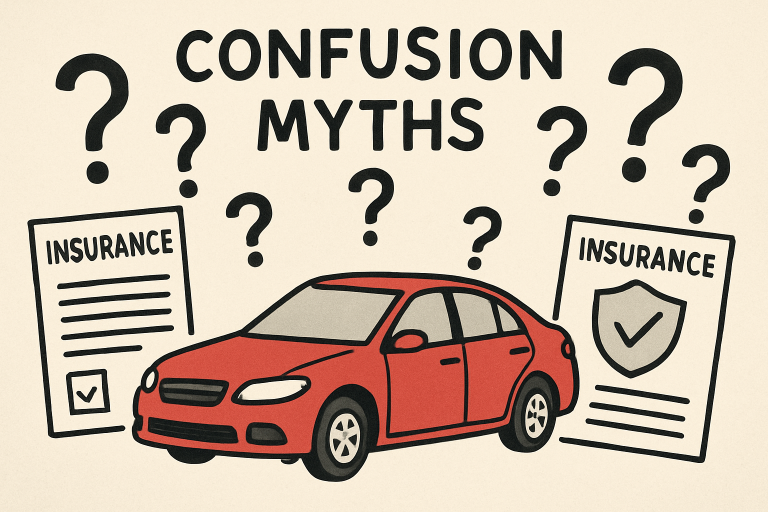Introduction
Navigating the world of auto insurance can be confusing, especially with so much misinformation circulating online and among drivers. Insurance myths can lead to financial risk and unexpected expenses, especially after an accident. It’s crucial to separate fact from fiction to make informed decisions. Misconceptions about insurance rates and policy coverage can be debunked to ensure peace of mind. These myths often become clear after an accident, causing stress and financial burden. Understanding the facts behind your policy helps prepare for the future.

Myth 1: Red Cars Cost More to Insure
Many drivers believe that having a red vehicle will automatically mean higher insurance premiums, associating the color red with speed and risk. However, this is a misconception. Insurance carriers do not consider car color when determining rates. Instead, they focus on the vehicle’s make, model, year, the cost of repairs, available safety features, and the driver’s history. As confirmed by Consumer Reports, factors such as mileage, zip code, and claims history matter far more than whether your car is red, blue, or silver.
Myth 2: Minimum Coverage Is Sufficient
It’s tempting to opt for the minimum insurance required by your state because it usually comes with a lower premium. However, relying on minimum coverage can backfire financially. Rising healthcare and repair costs mean that state-mandated limits might not be enough to cover medical bills or property damage from a serious accident. According to NerdWallet, drivers who only have minimum coverage risk paying out of pocket for significant expenses not covered by their policy. It’s advisable to assess your financial situation and risks carefully before choosing a barebones policy.
Myth 3: Comprehensive Coverage Covers Everything
Comprehensive coverage can be misleading because of its name. While it does cover losses resulting from theft, vandalism, natural disasters, and similar events not involving a collision, it does not pay for damages resulting from an accident with another vehicle or object. That’s what collision coverage is for. After a car accident, there are also specific exclusions that may leave you unprotected in certain scenarios, such as mechanical failures or regular wear and tear, as outlined in Forbes Advisor. It’s important to review your policy carefully to understand what’s covered and what isn’t. Additionally, consulting with your insurance agent can help clarify any doubts and ensure you have the appropriate coverage for your needs.
Myth 4: Credit Scores Don’t Affect Insurance Rates
Many policyholders are surprised to learn their credit habits factor into what they pay for auto insurance. In most states, insurers use a credit-based insurance score to help predict the likelihood of a future claim. Research suggests a correlation between credit scores and claims data, which is why better credit can result in a lower premium. Maintaining good credit habits can help reduce your insurance costs significantly.
Myth 5: Personal Items in Your Car Are Covered
If personal items like a laptop or golf clubs are stolen from your vehicle, your auto insurance policy likely will not reimburse you. Most standard policies exclude personal property. These losses may be covered by your homeowners or renters policy, assuming you carry one, and are subject to your deductible and policy limits. To reduce the risk of theft, always stow valuables out of sight and lock your vehicle.
Myth 6: Older Drivers Always Pay More
While some insurers may charge higher rates for older drivers due to the increased risk of injury in an accident, many offer specific discounts to senior drivers. Taking an approved defensive driving course, such as those offered by AARP, can help reduce premiums. Additionally, older drivers often drive fewer miles, which can be reflected in lower rates. Shopping around and asking about age-related discounts can lead to more affordable premiums.
Myth 7: Your Insurance Covers Anyone Who Drives Your Car
Coverage for drivers who occasionally borrow your vehicle depends on the specifics of your policy. While most insurance follows the car rather than the specific driver, if someone regularly drives your vehicle, they generally need to be named on your policy. Additionally, if a non-listed driver has an accident in your car, your policy will be the primary coverage, which could lead to increased premiums. It’s always wise to check your insurance terms and notify your provider if someone else drives your vehicle frequently.
Myth 8: New Cars Are Always More Expensive to Insure
It’s a common assumption that new cars are costlier to insure than used ones. While new vehicles often have higher repair costs and may be more expensive to replace, they also come with enhanced safety technology that can reduce the likelihood or severity of accidents. Insurers may reward this with lower premiums, especially for models with good safety ratings. It’s important to compare insurance quotes for both new and used vehicles before making a purchase.
Understanding the truths about car insurance empowers you to make better decisions, avoid costly surprises, and ensure you and your loved ones are sufficiently protected every time you hit the road.








